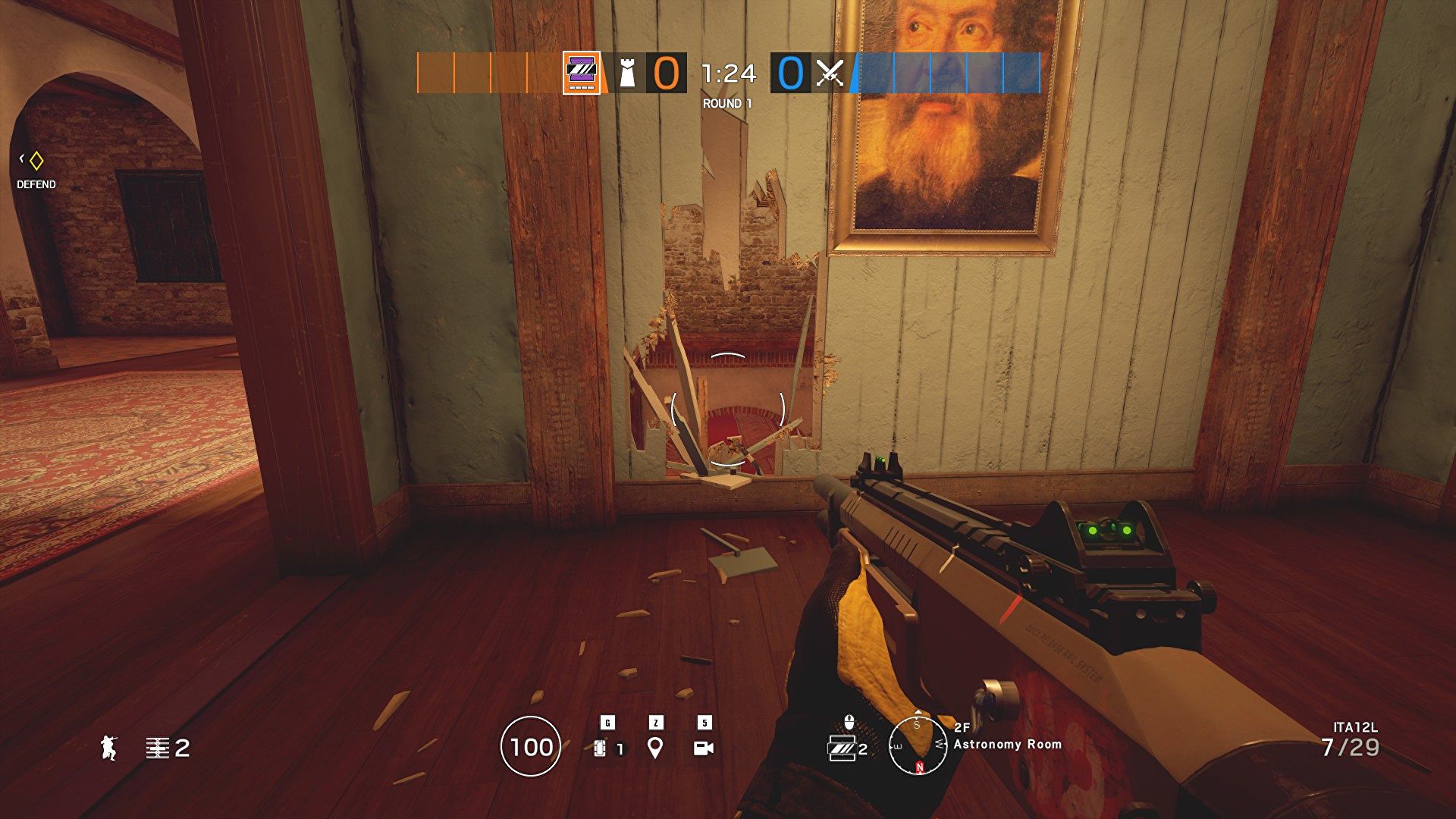How many game developers does it take to make a banana explode good? About six
Developers explain just how much work goes into tiny environmental details in games.

When you shoot a watermelon in a videogame, with how much detail should that watermelon explode?
After all, in theory, a developer could spend weeks building a fully dynamic fruit destruction engine (FDE) that responds to individual shotgun pellets and separates rind from seed. Or it could just imbue the melon with some simple code that makes it wobble away like a lifeless rock when you shoot it. Is a mango not entitled to the sweet of its insides, spraying everywhere?
Some recent Twitter disagreement did orbit around this peculiar question. Tweets over the last week comparing games' environmental interactivity—ranging from casual observations to trolling indictments of production practices—levied criticism at recent pre-release versions of Back 4 Blood and Halo Infinite while praising The Last of Us 2's apples. "We're at the point in the console war when fanboys are comparing fruit physics as some sort of measurement of a game's craftsmanship," summarized IGN's Destin Legarie.
Just gonna leave this here 🍌🍎🍉 #HaloInfinite pic.twitter.com/HdhcnFVQN7August 2, 2021
Every individual fruit in #TheLastofUsPart2 has been designed fully 3D and has it’s own physics! In fact this fruit basket alone has more physics and interactivity than any other xbox game! These clueless xbox zealots are beyond ridiculous 🥱 https://t.co/etZkj9UwZl pic.twitter.com/Rg6ZpnFUnmAugust 4, 2021
Let's be HONEST. #Back4Blood is on Game Pass for a reason. Imagine spending $60 on THIS. ZERO detail. ZERO immersion. ZERO care. pic.twitter.com/mt5FGJt2lrAugust 5, 2021
There wasn't much insight to be had beneath the tweets. But it did make me wonder: how much development effort does it take to make a great, high-fidelity fruit, a shatterable windshield, or disintegrating clay pot? And how do these crucial development decisions get seeded?
Virtual fruit experts weigh in
Seeking technical wisdom, I asked Torn Banner Studios, creator of a recent multiplayer game where you can kill fellow knights with a fish or a decapitated head, Chivalry 2.
James Arkwright, lead environment artist at Torn Banner, says that if we're comparing the effort it takes to make an exploding piece of fruit with larger development hurdles, yes, it's easier to make a watermelon blow up good. But that doesn't mean it isn't a "complicated," multi-disciplinary task.
"To make, say, a banana explode, you may need: a game designer to determine the rules and function of the banana explosion, a 3D artist to make the banana itself, a VFX artist to make the explosion, an audio designer to make it sound like a banana exploding, an engineer to make all of the above work correctly, a QA tester to ensure the exploding banana explodes correctly and doesn’t crash the game in the process, and potentially (many) others depending on the scope of the object," says Arkwright.
Keep up to date with the most important stories and the best deals, as picked by the PC Gamer team.
That's a minimum six-person effort. Practically a Banana Destruction Committee. And it makes sense: most studios don't run their sound, art, design, and programming through the same person, so multiple devs would all have to touch such a detail.
Some players [have] the expectation that games should grow larger and more immersive year after year
James Arkwright, Torn Banner Studios
As Arkwright puts it, if you want an object to animate, it has to produce multiple forms of feedback for the player. Creating that feedback usually means enlisting multiple departments. Arkwright goes as far as to say that "making these destructible background objects could easily be someone’s full-time job, a luxury that most smaller studios cannot afford," noting that bigger studios, yes, generally have more capacity to make this stuff look better, if they choose to.
I also spoke with Sébastien Laurent, technical director for the Games Team at Crytek, creators of Hunt: Showdown and an entire damn video game engine. Laurent agreed that interactive objects, unlike passive scenery, are a multi-person process. "When it comes to dynamic objects, many more departments have to be involved and there are wider ramifications," he says.
If you want a videogame sedan that dents, breaks, and explodes, it's not a matter of checking some backend boxes that magically enable destructibility. How many different sounds should a car make when you shoot it? Does the fender make the same sound as the tires? What if you blast it with a pistol, or hack the hood with a melee weapon? Though you might not give it more than a glance, a destructible car in an FPS like Back 4 Blood is essentially a small system of rules and layers of art working together in unison.

"Tech artists would have to rig [the car]," Laurent says, "animators would have to make proper animations for the doors, hood and trunk, VFX artists would need to create particle effects for the various destruction (glass shattering, dust coming off, burning, smoke) events, audio designers would need to make the sounds (glass shattering, doors creaking), UI designers would then have to create prompts for interaction, and technical designers would have to set up all the logic around it."
I think it's interesting that both developer respondents, who didn't have knowledge of each other's answers, gave the same headcount to complete the work: six people.
And the work of creating something as ordinary-seeming as an empty car gets even more complicated if you're considering that dynamic object's relationship with other game systems. "Can an open door block an AI? Does the AI need to know how to close doors? Will the cost of that non-static object still fit in our performance budgets?" asks Laurent. "Game developers therefore have to make a call about what objects are static and which ones are dynamic and if they serve the gameplay/overall ambience of the game as well as making sure the game doesn’t overrun the online limits. Hence, there is a fine balance between what objects are dynamic and which ones stay static, and we try to use this logic with our games as much as possible."
Developers were eager to remind me of the interrelated work of introducing anything new, however simple-seeming, to a game. "Every feature you add to a game adds future potential 'technical debt' in QA testing and bug fixing down the line," says Geoff "Zag" Keene, creator of Unfortunate Spacemen. "As complexity goes up, other departments have to grow to account for it. It adds up."
How do you like them apples?
Responding to some of the Twitter criticism of inert fruit, unbreakable windshields, and other less-than-realistic objects in games, Arkwright believes that this feedback is specific to videogames. Some players hold "the expectation that games should grow larger and more immersive year after year," he says. "It would be very odd to expect novels, for example, to grow larger by the year, and at this point in time every novel would be 5000 pages. The same could be said for movies, or television or any other media. For some reason the gaming industry has escaped the understanding that adding content for content’s sake is not necessarily a path towards a better experience."
Keene went further to shame these armchair comments from Twitter: "Nitpicking small graphics (like a bush not wiggling when the character moves through it) and damning the game as 'not getting it right' is only something you'd hear from someone without a passion of their own," he says. "Unless their passion is being an insufferable pedant, I suppose."
Understanding the layers of work and wider production considerations that go into creating lively dynamic objects in games will hopefully help us calibrate the harsh judgments we pass on virtual fruit. The opposing trend driving some of this nitpicky commentary, perhaps, is the increasing fixation on technical aspects of games among some corners of the community.
The impressive work of creators like Digital Foundry and 3kliksphilip, who comb over the technical aspects of games, sharpens our vision for details. PC Gamer's own performance analyses atomize how each individual graphics setting affects frame rate, per GPU. But this form of microscopic game dissection may also have the unintended consequence of making some of us inflate the importance of fine details like tickrate, frame pacing, and input lag, that weren't previously part of our vocabulary.

Evan's a hardcore FPS enthusiast who joined PC Gamer in 2008. After an era spent publishing reviews, news, and cover features, he now oversees editorial operations for PC Gamer worldwide, including setting policy, training, and editing stories written by the wider team. His most-played FPSes are CS:GO, Team Fortress 2, Team Fortress Classic, Rainbow Six Siege, and Arma 2. His first multiplayer FPS was Quake 2, played on serial LAN in his uncle's basement, the ideal conditions for instilling a lifelong fondness for fragging. Evan also leads production of the PC Gaming Show, the annual E3 showcase event dedicated to PC gaming.

